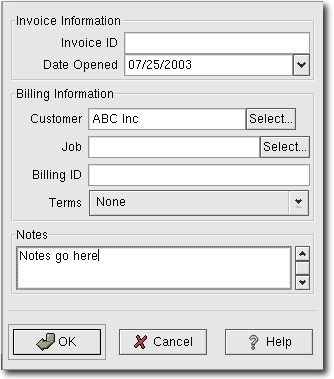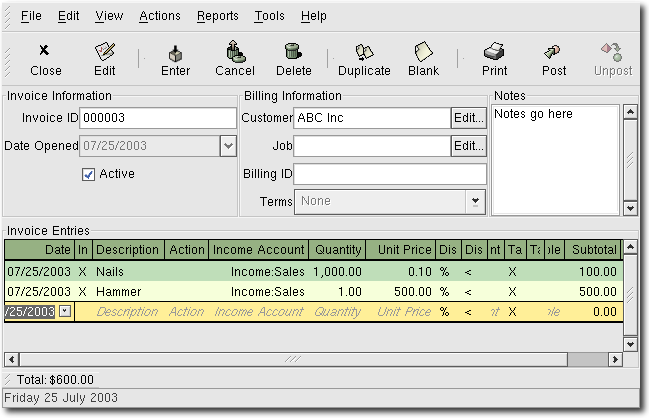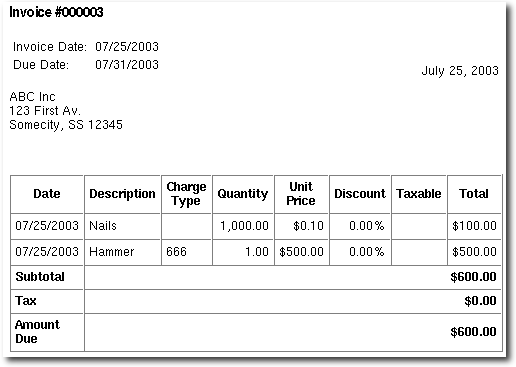An invoice is the paperwork you send to a customer requesting payment for a product or services rendered. GnuCash can be used to generate and track invoices.
To send an invoice to a customer you must first create a new invoice. This is accomplished using the application available at Business -> Customers -> New Invoice. The New Invoice window should be filled in appropriately:
Invoice Info - Invoice ID - the identification number of this invoice (IE: your internal number for this invoice). If you leave it blank, a number will automatically be generated for it.
Invoice Info - Date Opened - the date this Invoice was created.
Billing Info - Customer - the customer who is to receive this invoice.
Billing Info - Job (optional) - the customer job to associate with this invoice.
Billing Info - Billing ID - this is the customer's PO Number or other "customer reference number" that you should use to identify your invoices to this customer (and job, if you have one).
Billing Info - Terms - the payback terms agreement for this invoice, a list of preregistered terms is available within the pop up menu.

Creating a New Invoice
Once you fill in all the information for the new invoice, you will be presented with the Edit Invoice window.
From the Edit Invoice window you can enter an itemized list of things you sold on this invoice in a manner similar to how the account register works.

Edit Invoice Window
There are 15 columns in the Invoice Entries area:
Date - The date this item was sold
Invoiced? - X means the item is attached to this invoice, an empty box means the item is not attached to this invoice. If the box is empty you can attach the item to the invoice by first selecting the item row and then clicking in this box.
Description (optional) - what the item is called
Action (optional) - user defined field. Can place Cost Center info here, or use one of the 3 predefined actions, Hours, Material, or Project.
Income Account - which income account is credited with this income
Quantity - how many of the items you sold
Unit Price - the unit price of the item
Discount Type - type of discount, monetary value ($) or percentage (%)
Discount How - the discount can be computed after the tax is applied (>), before the tax is applied(<), or the discount and tax can be applied to the pretax value (=)
Discount (optional) - total discount (in monetary units or percentage, depending on Discount Type. You can leave blank for no discount.
Taxable? - is this item taxable? X means yes, a blank field means no.
Tax Included? - has the tax already been included in the unit price? X means yes, a blank field means no. For example, if there is 1 item of $100 with a tax of 5%, if Tax Included is empty then subtotal = $100 and tax = $5, whereas if Tax Included is true, then subtotal = $95 and tax = $5
Tax Table (optional) - this is a pop up menu of all the available tax tables. If you set the item as taxable then this tax table is used to compute the amount of tax.
Subtotal (uneditable) - computed subtotal for this item (less tax)
Tax (uneditable) - computed tax for this item
When you have finished entering all the items, Post the invoice.
When you have finished editing an invoice and are ready to print you must Post the invoice. You do not have to post the invoice immediately, and in fact you should only post the invoice when you are ready to print it. Posting an invoice will place the invoice transactions into an accounts receivable account. The Post Invoice window will appear asking you to enter the Post Date, the Due Date, a Description, and Post to Account (from which you can select from a list of A/Receivable accounts).

Post Invoice Window
To find a preexisting invoice, use the Business -> Customers -> Find Invoices application. From the results of the search, you can select an invoice to edit, or view.
 | Note |
|---|---|
Before you can edit a preexisting posted invoice, you will need to unpost it. | |
After you have posted an invoice, you should print it to send to your customer. This can be done from the Edit Invoice window using the Print button, or from within the Process Payment dialog, or from the main window: Reports -> Business Reports -> Printable Invoice. You can edit the invoice options to select the invoice you want to print. See the later section in this chapter on the Process Payment dialog for instructions on printing.
An example of the default GnuCash invoice print output is shown below.

Invoice Print Output
 | Note |
|---|---|
You can modify the appearance of the invoice, IE: add a company logo, etc. To do so, see the section in this chapter entitled "Changing the Invoice Appearance". | |
There is no easy way to assign an automatic starting invoice number. GnuCash will start with number 1 and increment from there. You can override the invoice number by typing an invoice number into the text box each time you create an invoice, but this is bound to get tiring and will sooner or later lead to duplicate numbers.
If, however, it is important that you be able to change the invoice starting number, there is a way, but unfortunately there is no UI interface to do it. You have to hand edit your XML data file (it should be right at the beginning of the file in the "counters" section).